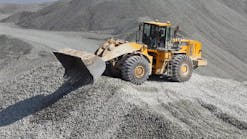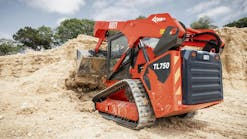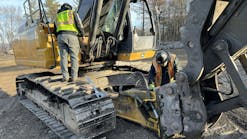The next time you go to the gas station, think about the preliminary work that went into the gasoline coming out of the pump. Construction, alone, requires contractors to obtain permits, spend days to excavate, doze and grade sites for oil rigs, build roads, and import needed materials on site to work. Then, the oil companies install oil rigs, cover the pit, and, over several years, pump crude oil that is delivered to refineries to make different grades of gasoline.
In western North Dakota, where recently discovered oil fields prompted oil companies to set up rigs, many contractors obtained work to build infrastructure, housing and retail to serve the workers. Harris Construction & Gravel, Inc., Kenmare, has been building oil sites and temporary and permanent roads into the sites.
“We’re working in the town of Ray and also working 20 miles west of Kenmare to build roads into the oil sites,” said Kirk Harris, vice president. “As long as there are pumping wells, there will be permanent roads to the sites.” Harris said one of his crews is building a mile-long road into a site and “after we get the road built, we will put gravel on the road and on the site. We’ll dig a pit for the rigs and put gravel in the pit too.”
Winter working conditions
During winter, Harris said, “we push away the snow first, the ground is frozen to a depth of one and a half to two feet, and we have to use excavators and dozers to tear up the road first. You can’t grade frozen ground with graders; when we get to a frozen section, we keep ripping with the dozer. We’ve run into frost that’s four or five feet down, and that’s hard on the excavators and dozers. We can’t pre-heat the ground because the large area is not worth heating.”
Harris explained that nothing is on the site until oil companies propose to set up equipment to dig oil wells in certain section of the land. “The companies must get approval from the state to dig the wells, provide a layout of how they want to lay the site and the roads to the site, and, ultimately, obtain the state’s approval as to where roads can be located.”
Oil companies hire surveyors to mark center lines for the roads, stake the perimeter of the entire site, and mark the well area within a foot of center. Harris Construction then installed stakes in the area where it will grade with its equipment to the specifications of the site.
Agreements with three companies
Since 2008, Harris Construction has built roads and sites for three different oil companies: Occidental Petroleum, EOG Corp. and the Hess Corp. “We go into the site, level about 3.5 acres, and dig a pit for the companies to set up their oil rigs and start drilling down about 10,000 feet,” Harris explained. “To get the oil out, they also have to drill horizontally for about 5,000 feet.”
The pit is usually 60 feet by 160 feet and 14 feet deep. “Most times, we use our dozers and scrapers to dig the hole, put the dirt into a pile at the site, and when the companies set up their materials in the hole, they line the pit with a heavy plastic line and cover up the hole using the dirt pile.
“For roads, we move some of the dirt into valleys in the road to make the roads as level as possible. We use our Caterpillar D7R, D7H, D8R and D6H dozers to remove the dirt and haul it with our scrapers to where it’s needed. All the roads we build are 28 feet wide.” Harris said his employees use lasers on top of a tripod with the receiver on the scraper. The information is sent to the receiver as the equipment operator drives around the site to obtain the specified grade.
Provides gravel
Harris Construction also provides Class 5 gravel for the roads and sites. “For Occidental Petroleum, we built four sites and a mile of road at each site. Then we provided 4,000 to 7,000 cubic yards of gravel per site.
“For Hess Corp., we’ve excavated, are building roads into the oil sites, and putting down scoria, a soft rock, that holds up better to rain and mud. One site has half a mile of road 28 feet wide. Some of the sites are beside a main road, and we build only a short access road. The ground is still frozen, but Hess has 15 rigs on different sites and we’re building roads for all of the sites.” Harris said his crew also is working in Ray for Hess.
In Stanley, in the heart of the Bakken Formation where oil was first discovered, Harris Construction is building roads and sites for EOG Corp. “Stanley is hopping. EOG has nine or 10 drilling rigs there and we’ve been working for them for two years,” said Harris.
He explained that the roads and sites are covered with gravel because heavy trucks would tear up paved roads and it would be too expensive to keep building or repaving roads and sites.
Install culverts
In some areas, Harris said, “We put in culverts through the roads to drain water and covered them with dirt. Some culverts are built close to the side of a hill to drain water and others are built depending on the level of the land. We’ve built seven or eight culverts in a mile of road to prevent water from covering the road, especially in areas where the roads are like hills.”
Harris Construction, which owns all of its equipment, expects to continue working for oil companies for the next two to three years because more oil companies are entering North Dakota. In winter, Harris said his crews can build a site with roads in about 10 days, but in warmer weather, construction requires about four days. The company does not pave as part of its work.
Oil was discovered in a new area, Three Forks/Sanish, near the Bakken and Harris Construction already received agreements from EOG Corp. to build sites and roads.
Harris said his father began the business in 1964 as a highway-heavy contractor, mainly working in North Dakota.





